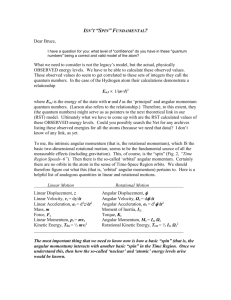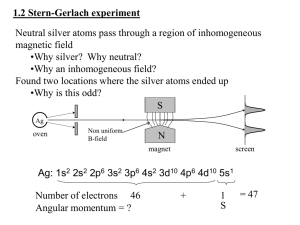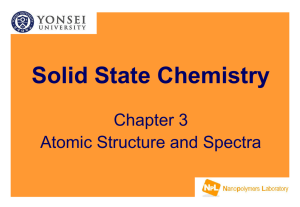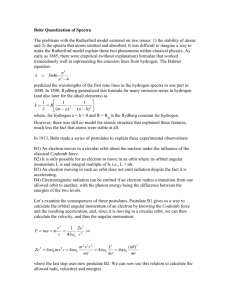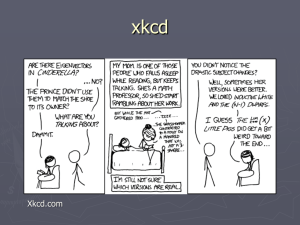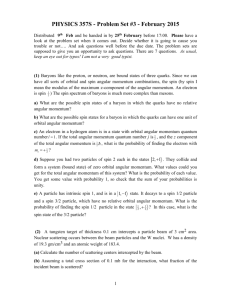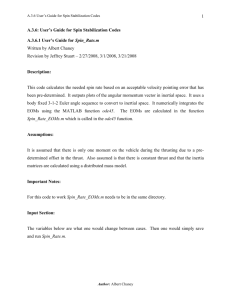Spin
advertisement
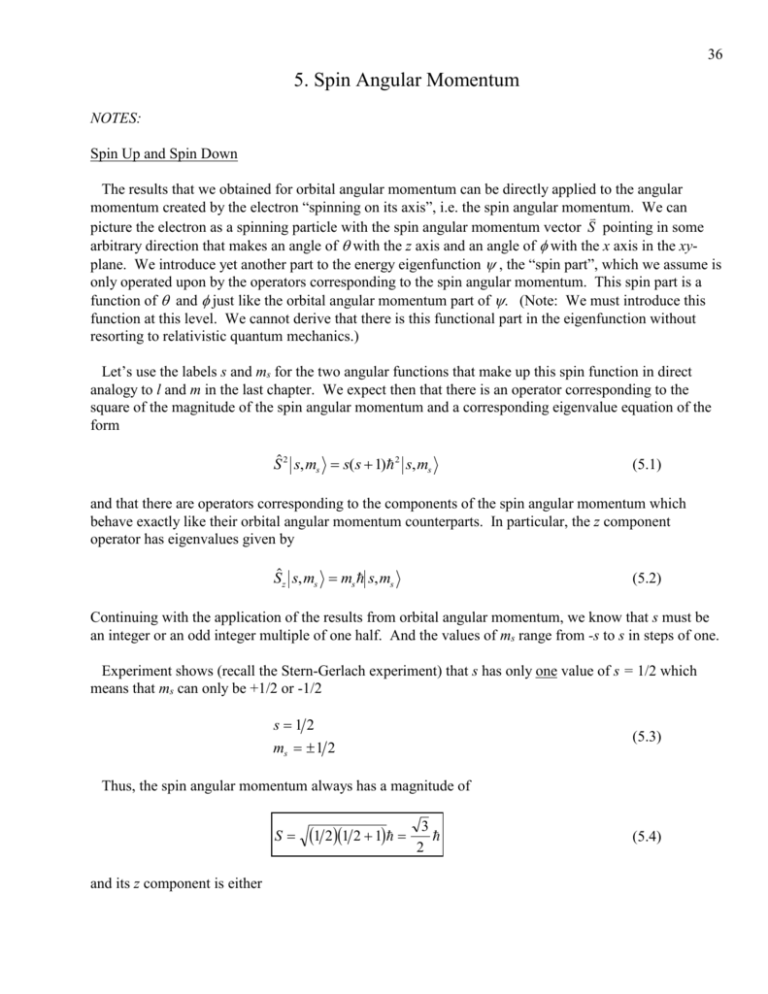
36 5. Spin Angular Momentum NOTES: Spin Up and Spin Down The results that we obtained for orbital angular momentum can be directly applied to the angular momentum created by the electron “spinning on its axis”, i.e. the spin angular momentum. We can picture the electron as a spinning particle with the spin angular momentum vector S pointing in some arbitrary direction that makes an angle of with the z axis and an angle of with the x axis in the xyplane. We introduce yet another part to the energy eigenfunction , the “spin part”, which we assume is only operated upon by the operators corresponding to the spin angular momentum. This spin part is a function of and just like the orbital angular momentum part of (Note: We must introduce this function at this level. We cannot derive that there is this functional part in the eigenfunction without resorting to relativistic quantum mechanics.) Let’s use the labels s and ms for the two angular functions that make up this spin function in direct analogy to l and m in the last chapter. We expect then that there is an operator corresponding to the square of the magnitude of the spin angular momentum and a corresponding eigenvalue equation of the form S 2 s, ms s( s 1) 2 s, ms (5.1) and that there are operators corresponding to the components of the spin angular momentum which behave exactly like their orbital angular momentum counterparts. In particular, the z component operator has eigenvalues given by Sz s, ms ms s, ms (5.2) Continuing with the application of the results from orbital angular momentum, we know that s must be an integer or an odd integer multiple of one half. And the values of ms range from -s to s in steps of one. Experiment shows (recall the Stern-Gerlach experiment) that s has only one value of s = 1/2 which means that ms can only be +1/2 or -1/2 s1 2 ms 1 2 (5.3) Thus, the spin angular momentum always has a magnitude of S and its z component is either 1 21 2 1 3 2 (5.4) 37 Sz 2 (5.5) Since there are only two possible values of ms, there are only two possible spin eigenstates. 1 1 , or or . 2 2 1 1 The state with S z 2 we call the down state and write it as , or or . 2 2 The state with S z 2 we call the up state and write it as We can also go ahead and define a spin raising and spin lowering operator as S S x iS y (5.6) S S x iS y such that Sˆ s, ms s( s 1) ms (ms 1) s, ms 1 (5.7) Sˆ s, ms s( s 1) ms (ms 1) s, ms 1 (5.8) and These operations are simply the operations for the orbital raising and lowering operators expressed in (4.53) and (4.54) with the appropriate changes for spin angular momentum. Because there are only two spin eigenstates, there are only four possible operations that result from (5.7) and (5.8): 1 1 1 1 S , (3 / 4) (1 / 2)(3 / 2) , 0 2 2 2 2 1 1 1 1 1 1 S , (3 / 4) ( 1 / 2)(1 / 2) , , 2 2 2 2 2 2 1 1 1 1 1 1 S , (3 / 4) (1 / 2)( 1 / 2) , , 2 2 2 2 2 2 (5.9) 1 1 1 1 S , (3 / 4) ( 1 / 2)( 3 / 2) , 0 2 2 2 2 These operations can be succinctly expressed as S 0 S S S 0 (5.10) 38 Fermions and Bosons Recall that the quantum number which quantizes the magnitude of the angular momentum is either an integer or an odd integer multiple of one half. Particles whose angular momentum magnitude quantum numbers are integers are called bosons. Particles whose angular momentum magnitude quantum numbers are odd integer multiples of one half are called fermions. We have seen an example of both kinds of particles. An electron is a fermion. However, the Hydrogen atom (an electron orbiting a proton) is a boson! A list of example fermions and bosons appears in Table 9-1 in Eisberg & Resnick (p. 310). Fermions include protons and neutrons. Bosons include alpha particles and photons. 39 PROBLEMS: [5.1] In direct analogy to Problem [4.4], show that the average value of the x and y components of the spin angular momentum are zero for an electron in the up state. Show that they are also zero for an electron in the down state.
